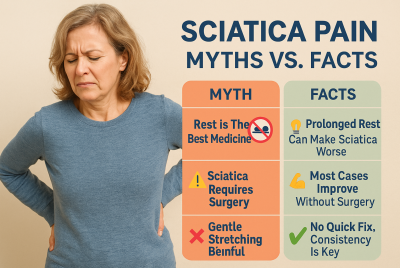Signs Of Sciatica Improving
Explore the key indicators of sciatica recovery! Delve into the signs of sciatica improving and learn when you’re on the path to relief. Discover the positive shifts indicating your symptoms of sciatica are improving. From reduced pain to better mobility, learn how to track your healing journey and adapt your treatment plan effectively. As someone passionate about sciatica health and eager to provide helpful suggestions, I understand the challenges and frustrations it can bring. However, I’m here to offer you some advice and suggestions on how to recognize the signs of sciatica improving. By identifying these signs, you can track your progress and find encouragement along your healing journey. So, let’s dive in and explore the positive indicators that indicate your sciatica is getting better.
Understanding Sciatica
Before we delve into the signs of improvement, let’s first understand sciatica. Sciatica refers to the pain radiating along the sciatic nerve, which runs from your lower back to your legs. Various factors, such as a herniated disc, spinal stenosis, or muscle imbalances, can cause it. The pain can range from mild discomfort to sharp and debilitating sensations, often affecting one side of the body.
What Causes Sciatica Pain To Flare Up?
Sciatica pain flares up for various reasons. A herniated disc pressing on the sciatic nerve is a common cause. Spinal stenosis, or spinal canal narrowing, can also trigger symptoms. Pregnancy often exacerbates sciatica due to increased pressure on the spine. Sudden movements like twisting or lifting heavy objects may worsen the pain. Poor posture, especially sitting for extended periods, can irritate the condition. Muscle spasms in the lower back or buttocks can contribute to flare-ups. Lifestyle factors like obesity and lack of exercise make individuals more susceptible. Emotional stress can also intensify the symptoms, complicating the healing process.
What Is The Healing Process Of Sciatica?
The healing process of sciatica varies from person to person but generally involves several key steps. First, doctors diagnose the condition through physical exams and imaging tests. Pain management usually starts with over-the-counter pain relievers and may escalate to prescription medications. Physical therapy plays a crucial role in improving posture and strengthening muscles. Some people find relief through alternative therapies like acupuncture. Corticosteroid injections can target inflammation in severe cases. Surgery becomes an option when conservative treatments fail. Throughout the process, lifestyle changes such as weight loss and regular exercise can contribute to recovery. Periodic assessments help tailor the treatment plan.
How To Know If Your Sciatica Is Getting Better
Signs Of Sciatica Improving
Here are the signs of improving sciatica or how do you know when sciatica is getting better
Reduction In Pain Intensity
One of the most noticeable signs that your sciatica is improving is a reduction in pain intensity. As your body heals and inflammation decreases, you may begin to experience less frequent and less severe bouts of pain. The sharp, shooting pain that once hindered your daily activities may gradually subside, allowing you to move more easily and comfortably.
Increased Range Of Motion
Another positive sign of sciatica improvement is an increased range of motion. As your pain subsides, you may find that you can move your legs, hips, and lower back more freely. Activities that were once challenging, such as bending forward or lifting objects, may become easier and less restricted. This increased mobility is an encouraging indicator that your sciatica is on the path to improvement.
Improved Muscle Strength
Sciatica often weakens the muscles in the affected leg, leading to difficulties in performing simple tasks like walking or climbing stairs. However, as your sciatica improves, you may notice a gradual return of muscle strength. Walking longer distances becomes less exhausting, and you might find it easier to engage in light exercises or physical activities that were previously challenging. The restoration of muscle strength is a promising sign that your sciatica is getting better.
Decreased Numbness And Tingling
Numbness and tingling sensations, also known as paresthesia, are common symptoms of sciatica. These sensations can make your leg feel weak and affect your balance. However, as your sciatica improves, you may experience a decrease in numbness and tingling. The pins-and-needles feeling may gradually subside, allowing for improved sensory function in the affected leg.
Better Posture And Alignment
Sciatica can impact your posture and alignment due to the pain and muscle imbalances it causes. However, as your sciatica improves, you may notice positive changes in your posture. Your spine becomes straighter, and your body adopts a more aligned position. This improvement in posture not only contributes to your overall well-being but also supports the healing process of your sciatica.
What Are The Last Stages Of Sciatica
The last stages of sciatica generally involve marked improvement and symptom resolution. By this point, patients have usually undergone various treatments like medications, physical therapy, or even surgery. As symptoms diminish, individuals can engage in more physical activities without experiencing significant discomfort. Exercise regimens often shift from purely therapeutic exercises to more general fitness routines. Pain management strategies may still include occasional over-the-counter medication but generally require less medical intervention. Continued focus on good posture and ergonomic practices helps prevent relapses. Periodic medical check-ups can confirm the recovery and adapt the treatment plan if needed, thereby concluding the healing process.
Does Sciatica Pain Come And Go?
Sciatica pain often comes and goes in episodes. The pain appears intermittently for some individuals and might improve with rest or simple home remedies. In other cases, specific activities like sitting for prolonged periods, bending, or lifting can trigger flare-ups. Pain can vary in intensity, ranging from mild discomfort to severe, incapacitating agony. The duration of each episode can also differ, lasting from a few hours to several weeks. While some people experience long stretches of relief between episodes, others may suffer from more constant, chronic pain. Monitoring your activities and symptoms can help you identify and avoid triggers for flare-ups.
Does Sciatica Ever Fully Heal?
The possibility of sciatica fully healing depends on the underlying cause and the effectiveness of treatment. Many people experience significant relief and return to normal activities after undergoing treatments like medication, physical therapy, or surgery. Some might consider this a full healing. However, others may continue to experience occasional flare-ups or residual symptoms. Lifestyle factors such as maintaining a healthy weight, exercising regularly, and practicing good posture can relieve long-term stress. Although some individuals may never experience sciatica symptoms again, others may deal with recurring episodes, especially if underlying issues like herniated discs or spinal stenosis are not fully addressed.
Factors Affecting Sciatica Improvement
Several factors can influence the improvement of sciatica. Considering and addressing these factors can enhance your chances of experiencing relief and recovery.
Proper Treatment And Management
Seeking appropriate medical treatment and following the advice of healthcare professionals is crucial for sciatica improvement. Your doctor may recommend a combination of medication, physical therapy, chiropractic care, or other modalities to alleviate your symptoms and promote healing. Adhering to your treatment plan is essential for optimal recovery.
Regular Exercise And Physical Therapy
Engaging in regular exercise and physical therapy can significantly contribute to sciatica improvement. Targeted exercises and stretches help strengthen the muscles supporting your spine and improve flexibility. A physical therapist can guide you through specific exercises tailored to your condition, ensuring you perform them correctly and safely.
Lifestyle Modifications
Making certain lifestyle modifications can also aid in your journey toward sciatica improvement. Avoiding activities that exacerbate your pain, such as heavy lifting or prolonged sitting, can help prevent further irritation of the sciatic nerve. Additionally, maintaining a healthy weight, adopting a nutritious diet, and quitting smoking can promote overall well-being and support the healing process.
Stress Reduction Techniques
Stress can intensify pain and hinder the healing process. Incorporating stress reduction techniques into your daily routine can be beneficial for sciatica improvement. Practice relaxation exercises, such as deep breathing or meditation, to help calm your mind and body. Consider activities like yoga or tai chi, which promote relaxation, flexibility, and gentle movement.
Massage For Sciatica Pain
Massage therapy can be a beneficial complementary treatment for relieving sciatica pain. By reducing muscle tension, improving blood circulation, releasing endorphins, increasing flexibility, and promoting relaxation, massage helps alleviate pain and support the healing process. Remember to consult with your healthcare provider and choose a qualified massage therapist to ensure the best results. Incorporating massage therapy into your sciatica treatment plan may provide you with the relief and comfort you deserve on your journey to recovery.
How I Cured My Sciatica
Tips For Promoting Sciatica Improvement
Now that we’ve covered the signs and factors affecting sciatica improvement, let’s explore some practical tips to facilitate your healing process:
Follow Medical Advice And Treatment Plan
Listen to your healthcare provider and follow their advice and treatment plan diligently. They have the expertise to guide you toward recovery.
Engage In Gentle Stretching And Strengthening Exercises
Perform exercises your physical therapist recommends to strengthen the muscles supporting your spine and improve flexibility. Remember to start gently and gradually increase intensity.
Maintain Good Posture
Be mindful of your posture throughout the day. Sit and stand up straight, avoiding slouching or hunching forward. Use ergonomic supports, such as a lumbar roll or a standing desk, if needed.
Avoid Prolonged Sitting Or Standing
Alternate between sitting and standing, taking breaks to stretch and move around. If you have a desk job, consider using a standing desk or using a cushioned mat for support.
Apply Heat Or Cold Therapy
Experiment with heat or cold therapy to find out what provides relief for you. Applying a heating pad or taking a warm bath can help relax tense muscles, while cold packs or ice wrapped in a cloth can reduce inflammation.
Practice Stress Management
Incorporate stress reduction techniques into your routine, such as deep breathing exercises, mindfulness, or engaging in hobbies that bring you joy and relaxation.
What Should You Not Do With Sciatica?
When dealing with sciatica, there are specific actions you should avoid to prevent exacerbating the condition. Do not sit for extended periods, as this can increase pressure on the sciatic nerve. Avoid lifting heavy objects, especially with poor form, as this can worsen your symptoms. Refrain from high-impact exercises like running and jumping, which may intensify pain. Steer clear of sudden, jerky movements that can strain your lower back. Don’t wear high heels; they alter your posture and put extra stress on the lower spine. Finally, resist the temptation to self-medicate with high doses of over-the-counter pain relievers without consulting a healthcare provider.
Signs Sciatica Is Getting Worse
Signs that sciatica is getting worse can manifest in various ways. Intensifying pain in the lower back, buttocks, or leg often indicates a worsening condition. The increasing frequency of flare-ups or persistent pain that doesn’t improve with rest or medication is another red flag. Reduced mobility, and difficulty standing or walking, highlight escalating severity. Experiencing numbness, tingling, or muscle weakness in the affected leg suggests nerve damage. Loss of bowel or bladder control is a critical symptom requiring immediate medical attention. If you notice a significant decrease in your quality of life due to sciatica symptoms, consult a healthcare provider promptly for evaluation and treatment adjustment.
When To Seek Medical Help
While recognizing the signs of sciatica improvement is essential, knowing when to seek medical help is also important. If you experience severe pain, sudden loss of bladder or bowel control, or worsening symptoms despite following self-care measures, consult your healthcare provider promptly. They can assess your condition and recommend appropriate interventions.
Frequently Asked Questions (FAQs)
How long does it take for sciatica to improve?
The duration of sciatica improvement varies for each individual. It can take weeks to months, depending on factors such as the underlying cause, severity of the condition, adherence to treatment, and lifestyle habits. Consistency with self-care measures and following medical advice can contribute to a faster recovery.
Can sciatica come back after improvement?
While sciatica can improve, there is a possibility of it recurring. It’s important to continue practicing good posture, engaging in regular exercise, and maintaining a healthy lifestyle to reduce the risk of sciatica flare-ups.
Does pins and needles mean my sciatica is getting better?
Pins and needles don’t necessarily indicate that your sciatica is getting better. This sensation often signifies nerve irritation or compression. If the symptom persists or worsens, consult a healthcare provider for proper diagnosis and treatment.
Are there any natural remedies that can help with sciatica improvement?
Natural remedies such as applying warm or cold packs, practicing relaxation techniques, and using herbal supplements may provide temporary relief. However, consulting with a healthcare professional is crucial to ensure their safety and efficacy for your specific condition.
Can I still exercise if I have sciatica?
Yes, exercise can be beneficial for sciatica improvement. However, it’s essential to consult with a healthcare professional or a physical therapist who can guide you through appropriate exercises and ensure you don’t exacerbate your symptoms.
Extra FAQs Related To Signs Of Sciatica Improving
Does tingling mean healing?
Tingling doesn’t necessarily mean healing. While it could signify nerve regeneration in some cases, it often indicates ongoing nerve irritation or compression. Consult a healthcare provider for an accurate diagnosis and appropriate treatment plan.
What is the longest time sciatica can last?
The duration of sciatica varies, but in chronic cases, symptoms can persist for more than 12 weeks. However, with proper treatment, most people experience relief within a few weeks to a few months.
Can stress worsen sciatica?
Stress can contribute to muscle tension and inflammation, which can exacerbate sciatic pain. Managing stress through relaxation techniques and reduction practices can help alleviate symptoms and support healing.
Signs Of Sciatica Improving – Conclusion
In conclusion, sciatica improvement is possible, and recognizing the signs of sciatica is improving can provide encouragement and motivation along your healing journey. Reduction in pain intensity, increased range of motion, improved muscle strength, decreased numbness and tingling, and better posture and alignment are all positive indicators of sciatica improvement. By considering factors such as proper treatment, regular exercise, lifestyle modifications, and stress reduction techniques, you can enhance the chances of sciatica improvement.
Remember to follow medical advice, engage in appropriate exercises, maintain good posture, avoid prolonged sitting or standing, and apply heat or cold therapy as needed. Stay positive, be patient with yourself, and seek medical help if necessary. You’re on your way to a healthier, more comfortable life!
Disclaimer
Please note that this article should not replace professional medical advice. Consult a healthcare professional for an accurate diagnosis and tailored treatment plan.
👉 Explore more:




